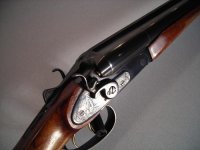A guide for identifying Soviet SxS shotguns available in North America.
Disclaimers:
- This is just my interpretation of scattered publicly available information and my personal observations. I like to structure information and hate when there is no simple guide, so here it is.
- I am not aware of any serious attempts to research, document, and publish the history of these shotguns. Articles in popular magazines and websites are all we have.
- Very often, information is conflicting, so you will be the judge and I'm sure this guide has some inaccurate information.
- The goal of this guide is to help you identify and understand what you have.
- The guide is limited to SxS shotguns because I have no interest in O/U or single barrel models.
- I plan to keep extending the guide as long as I have time and interest.
Intro and a bit of history.
Why Soviet shotguns are interesting subject for research, collecting and use? The represent products of the country that doesn't exist anymore, they were made mostly on military firearm factories and similar processes of quality control resulted in quite reliable and sturdy models made from quality materials. They did not have the most technological advancements and features, no. They never were "the best shotguns". But they were honest workhorses of the bygone era and they deserved to be remembered in this way. Variety of the models, calibres, grades and variants of the same model creates a lot of opportunity for collectors.
As a side note: the number in the model designation refers to the year of adoption up until IJ-58 (e.g., IJ-58 = model 1958). After that, the number started referencing an internal model ID and had nothing to do with the year (e.g., IJ-26).
We are going to start with Izhevsk. And we will begin with items I have never seen here, just for reference. There were several state Izhevsk factories that manufactured shotguns, and through time there were changed and reorganizations, but for the sake of simplicity of this guide we will consider them as a single entity.
In 1934, the “hunting rifles workshop” of Izhevsk factory was reorganized into a larger “shop,” or department. This new department continued production of:
- IJ-5 – the last modernization of the Iver Johnson single-barrel shotgun, produced in Izhevsk until 1941 and after 1945 in Zlatoust. Zlatoust also introduced the ZK modification.
- IJ-BK – 12ga and 16ga SxS, with internal hammers on side plates. Model of 1933, manufactured 1934–1938. The top lever acted as both lock and cocking lever. The letter "B" means "bezkurkov," i.e., "without hammers." Markings could read "Иж.Б.К" ("Ij.B.K.") As you can imagine, it was a rather clunky design, really hard to use and not very popular.


After IJ-BK came:
- IJ-B-36 (1937–1946, markings: "Иж.Б.36" / "Ij.B.36") - 12ga and 16ga, with traditional cocking system
- IJ-B-36M (1947, small batch with ejectors) – 12ga and 16ga, with traditional cocking system
- IJ-B-46 (16ga only, model of 1946)
- IJ-B-47 (12ga and 16ga, model of 1947)
IJ-B-36 (from public sources)

The next planned models were:
- IJ-49 – a rework based on German Sauer shotgun (Model 8, Anson & Deeley boxlock action mated with the IJ-B-47 frame)
- Izhevsk version of the Zlatoust ZK modification of the original IJ-5
Available models guide.
IJ-54 was a further Soviet take on the Sauer Model 8. The shotgun had a Greener crossbolt and cocking indicators. Made in 1955–1969, it was the first truly decent and popular model, and some sources believe it was the first USSR model successfully exported abroad. The drawbacks were its weight and manufacturing cost. It was also considered that 12ga was too powerful and not the best choice for commercial hunting, which was the big part of USSR export.
Initially offered in 12ga, and later in 16ga and 20ga. Originally, hammers were not rebounding, but after the IJ-57 development (see below), that was updated without changing the model name.
IJ-54 (from author collection). Note following visually identifiable features: straight line of wood joint, Greener crossbolt, cocking indicators, IJ-54 markings on the bottom of the frame.




IJ-57 – 16ga, eliminated the Greener crossbolt, had rebounding hammers. Only 20,000 were made and it is very hard to find. I have no information if they were ever exported, so most likely not available on our market.
IJ-57 (from public sources)

Last edited:
























































































